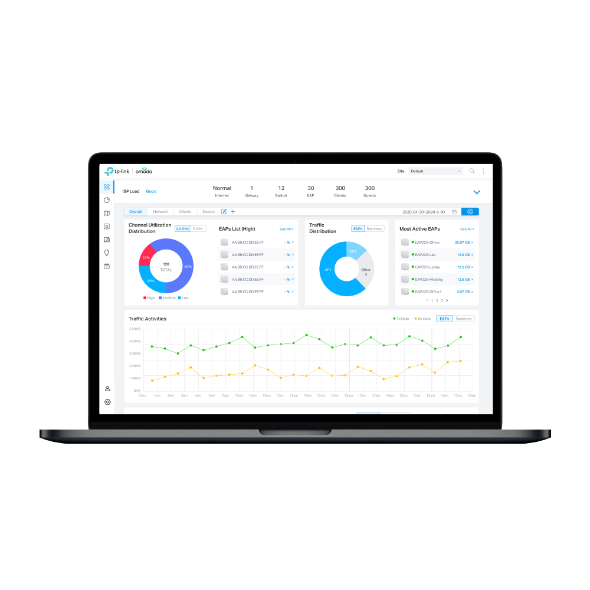Frequently asked questions of EAP Series Access Points
Q1: How many devices can the Omada controller manage?
A: Actually, the management scale of the Omada Controller depends on the properties of the Omada Controller host. The recommended requirements of the Omada Controller host are: Intel I3 CPU, 2GB RAM, 10G HDD or above. With these properties, the recommended management scale of the Omada Controller 2.4.x is 500 units.
Q2: How many SSIDs do the EAP products support?
A: There is no limitation of numbers to create SSIDs in the Omada Controller; but different EAP products support different numbers of SSID. For example, EAP245 supports 16 SSIDs (8 for each band). For detailed information of each model, please refer to the Specification or Datasheet on the official website for help.
Q3: What are the supported operating system for Omada Controller software?
A: As of now it supports Microsoft Windows 7/8/10/Server. Supporting 64-bit Linux operating system, including Ubuntu 14.04/16.04/17.04, CentOS 6.x/7.x and Fedora 20 or above. Mac OSX is not supported at present.
Q4: Which ports does EAP Controller use?
A: 8043 (TCP) for https, 8088 (TCP) for http, 27001 (UDP) for controller discovery, 27002 (TCP) for controller searching, 27217(TCP) for mongo DB server (This used to be 27017(TCP) before EAP Controller 3.0.0), 29810 (UDP) for EAP discovery, 29811 (TCP) for EAP management, 29812 (TCP) for EAP adoption, 29813 (TCP) for EAP upgrading. Make sure these ports are not occupied by other applications when you run EAP controller.
Q5: What is the Device Account used for?
A: In Omada Controller, there is one parameter called Device Account. When you running the controller for the first time, the Device Account will be initialized to the same as the administrator account automatically.
Once the EAP being adopted, Device Account will be pushed to EAP device to replace the username and password of the device.
Q6:What’s the status of EAP devices if I forget EAP in the Omada Controller?
When you choose to forget this EAP in Omada Controller_V2.x or higher version, all settings of EAP will reset to factory default. However, when you choose to forget this EAP in Omada Controller_V1.x, all settings of EAP will keep the same as it is adopted. The username and password of EAP device also keep the same as the Device Account on Omada Controller.
Q7: Can I manage the EAP devices by Omada Controller wirelessly?
A: It is not recommended to manage your EAP network by Omada Controller wirelessly. Because the Omada Controller will issue all the settings to the EAP devices after they are adopted. For example, if the SSID or security mode configurations change, the wireless connection will be broken and then you may need to reconnect to it again. So it is recommended to manage the EAP network via the wired connection.
Q8: Should I keep the controller running after I have finished the configuration?
A: EAPs can run in the standalone mode without the controller. But some functions, like Captive Portal and scheduled operations which depend on the Omada Controller. So if you use these functions, you need to keep the EAP Controller running.
Q9: Can EAP controller manage EAPs in different subnets?
A: Yes, Omada Controller supports L3 management. For more information, please refer to FAQ-1359 & FAQ-1360.
Q10: Can an EAP device be managed by two different Omada Controllers?
A: No. An EAP device can only be managed by one Omada controller. In fact only one Omada controller is allowed to run in the same local area network.
Q11: If I restart the Omada controller, will the EAP device also reboot?
A: No. The EAP device will keep on running.
Q12: Can I manage my EAP devices across the Internet?
A: Yes, about how to manage EAPs across the Internet, please refer to FAQ-1361 & FAQ-1362 for more information.
Q13: Why can’t I login to the EAP's management interface?
A: Usually there are two cases.
Case 1: 403 Forbidden
After the EAP is adopted by the Omada controller, you can only change the configurations and check the status of the EAP on the Omada controller. If you access the EAP's management interface, you will receive a 403 Forbidden error page.
Case 2: Username or password incorrect
The User Account of EAP Device will be changed to the Device Account after it is adopted by Omada controller. Even the EAP is no longer managed by the Omada Controller, all settings are kept. You should use Device Account to login to the EAP’s management page unless you restore it to the factory default.
Q14: Why won’t it redirect me to the portal page when I try to search something in the Google Chrome?
A: Google Chrome use https to search by default, but https cannot be redirected. So please try to visit an http page and it will be able to redirect you to the portal page. But for Omada Controller 2.6.0 or above, you can redirect the portal page by https website, too.
Q15: How to manually restore the EAP device to the factory defaults?
A: With the device powered on, press and hold the RESET button for about 5 seconds until the LED flashes red/green/yellow alternatively twice, then release the button. The device will restore to factory default settings.
Q16: How to reboot EAP via Omada Controller?
A: If you want to reboot some specific APs, please go the Access Point – Connected list on the Omada Controller management’s page, find the AP you want to reboot and then click the reboot button  on the right.
on the right.
If you want to reboot all the EAPs in batch, please go to the System – Reboot Schedule on the Omada Controller’s management page and set up the schedule. The EAPs will reboot automatically according to your schedule.
Is this faq useful?
Your feedback helps improve this site.
TP-Link Community
Still need help? Search for answers, ask questions, and get help from TP-Link experts and other users around the world.










4.0-F_normal_1593323197059j.png)